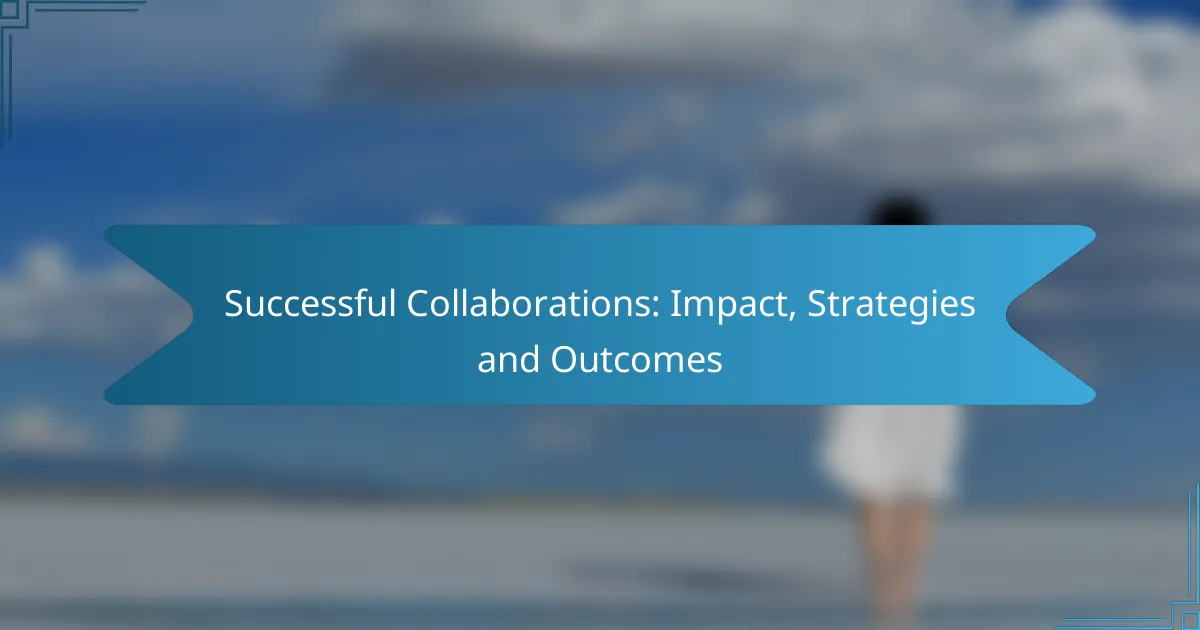Effective partnerships are essential for achieving shared objectives and fostering mutual success in any collaborative endeavor. By prioritizing clear communication and leveraging local resources, organizations can build and sustain meaningful alliances that thrive over time. Advocacy plays a crucial role in these partnerships, as it highlights mutual benefits and engages stakeholders to strengthen the collective impact.

How to Build Effective Partnerships in the UK?
Building effective partnerships in the UK requires a clear understanding of shared objectives and strong communication. By focusing on common goals and leveraging local resources, organizations can create sustainable collaborations that drive mutual success.
Identify common goals
Identifying common goals is crucial for any partnership. Both parties should engage in open discussions to outline their objectives and expectations, ensuring alignment from the outset. This shared vision fosters commitment and guides decision-making throughout the partnership.
Consider using a collaborative framework to map out these goals. For example, a joint project might aim to increase community engagement by a specific percentage over a year, providing a clear target for both partners.
Leverage local networks
Utilizing local networks can significantly enhance partnership effectiveness. Engaging with community organizations, industry groups, and local authorities can provide valuable insights and resources. These connections can also facilitate introductions to potential stakeholders and collaborators.
For instance, participating in local business forums or community events can help partners tap into existing relationships and gain credibility within the community, which is essential for long-term success.
Establish clear communication
Clear communication is the backbone of any successful partnership. Establishing regular check-ins and updates ensures that all parties remain informed and engaged. Utilizing various communication tools, such as emails, meetings, and collaborative platforms, can help maintain transparency.
It’s beneficial to set communication protocols at the beginning of the partnership. For example, agreeing on a weekly update schedule can help prevent misunderstandings and keep everyone aligned on progress and challenges.
Utilize partnership platforms
Partnership platforms can streamline collaboration and enhance efficiency. These digital tools allow partners to share resources, track progress, and manage tasks in one centralized location. Popular options include project management software and shared document platforms.
Choosing the right platform depends on the partnership’s specific needs. For instance, if the focus is on project tracking, tools like Asana or Trello may be ideal, while Google Drive can facilitate document sharing and collaboration.
Set measurable objectives
Setting measurable objectives is essential for evaluating partnership success. Establishing specific, quantifiable targets allows partners to track progress and make data-driven decisions. Objectives should be realistic and achievable within a defined timeframe.
For example, partners might aim to increase joint marketing reach by 20% within six months. Regularly reviewing these objectives can help identify areas for improvement and celebrate successes, reinforcing the partnership’s value.

What Strategies Sustain Partnerships Long-Term?
Sustaining partnerships long-term requires consistent communication, shared goals, and a commitment to mutual growth. By implementing effective strategies, partners can navigate challenges and foster a collaborative environment that benefits all parties involved.
Regular check-ins
Regular check-ins are essential for maintaining open lines of communication and addressing any issues promptly. Schedule these meetings at consistent intervals, such as monthly or quarterly, to discuss progress, challenges, and future plans.
During check-ins, partners should review shared goals and assess whether they are on track. This practice not only strengthens relationships but also ensures accountability and alignment on objectives.
Shared resources
Sharing resources, such as knowledge, tools, and finances, can significantly enhance the effectiveness of a partnership. Consider pooling budgets for joint projects or sharing access to specialized software that benefits both parties.
Establish a clear agreement on how resources will be utilized and monitored. This transparency helps build trust and ensures that both partners feel equally invested in the partnership’s success.
Mutual accountability
Mutual accountability involves both partners taking responsibility for their roles and commitments. Establish clear expectations and deliverables from the outset, and regularly evaluate each partner’s contributions.
Implementing a system for tracking progress can help maintain accountability. For example, using shared project management tools allows both parties to visualize tasks and deadlines, fostering a sense of ownership over the partnership’s outcomes.
Adapt to changes
Partnerships must be flexible and adaptable to thrive in changing circumstances. Regularly assess external factors, such as market trends or regulatory shifts, that may impact the partnership.
Encourage open discussions about potential changes and be willing to adjust strategies as needed. This adaptability not only helps partners navigate challenges but also positions them to seize new opportunities together.

How to Advocate for Partnerships Effectively?
Advocating for partnerships effectively involves clear communication, demonstrating mutual benefits, and actively engaging stakeholders. By showcasing successes and leveraging joint efforts, organizations can build stronger alliances that drive shared goals.
Showcase success stories
Highlighting successful partnerships is crucial for advocacy. Share case studies that illustrate how collaborations have led to positive outcomes, such as increased revenue or enhanced community impact. Use real metrics and testimonials to add credibility.
Consider creating a dedicated section on your website or in newsletters that features these success stories. This not only builds trust but also inspires potential partners by showing what is achievable through collaboration.
Engage in joint marketing
Joint marketing initiatives can amplify the reach of both partners. Collaborate on campaigns that highlight the strengths and offerings of each organization, ensuring that messaging aligns with shared values and goals. This can include co-branded materials, events, or online promotions.
Set clear objectives for these marketing efforts, such as increasing brand awareness or generating leads. Regularly assess the effectiveness of these campaigns to refine strategies and maximize impact.
Utilize social media
Social media platforms are powerful tools for advocating partnerships. Use them to share updates, success stories, and joint initiatives, engaging audiences with interactive content like polls or live Q&A sessions. This fosters community and encourages dialogue.
Establish a consistent posting schedule and use relevant hashtags to increase visibility. Monitor engagement metrics to understand what resonates with your audience and adjust your approach accordingly.

What Are the Key Criteria for Selecting Partners?
Selecting effective partners hinges on several key criteria that ensure mutual benefit and alignment. The right partners can enhance your capabilities, expand your reach, and strengthen your market position.
Alignment of values
Alignment of values is crucial when selecting partners, as shared principles foster trust and collaboration. Partners who prioritize similar ethical standards, social responsibility, and long-term goals are more likely to work harmoniously.
To assess alignment, consider conducting values assessments or workshops where both parties can discuss their missions and visions. This can help identify potential conflicts and ensure a unified approach to decision-making.
Complementary strengths
Complementary strengths refer to the unique capabilities that each partner brings to the table, which can enhance overall performance. For instance, one partner may excel in technology while another has strong marketing skills, creating a balanced and effective partnership.
When evaluating strengths, create a skills matrix to visualize each partner’s competencies. This can help identify gaps and opportunities for collaboration, ensuring that both parties can leverage their strengths effectively.
Market reputation
Market reputation plays a significant role in partnership selection, as a strong reputation can enhance credibility and attract customers. Partners with positive public perception can help bolster your brand image and open doors to new opportunities.
Research potential partners through customer reviews, industry reports, and social media presence. Look for partners who have a history of reliability and ethical practices, as these traits are indicative of a trustworthy collaboration.

How to Measure Partnership Success?
Partnership success can be measured through various metrics that reflect both qualitative and quantitative outcomes. Key indicators include shared goals achievement, stakeholder satisfaction, and financial performance.
Key Performance Indicators (KPIs)
KPIs are essential for evaluating the effectiveness of a partnership. Common KPIs include revenue growth, customer retention rates, and the number of joint initiatives launched. Establishing specific, measurable targets for these indicators helps in tracking progress over time.
For example, a partnership aiming to increase sales might set a KPI of a 15% revenue increase within a year. Regularly reviewing these KPIs allows partners to adjust strategies as needed.
Feedback Mechanisms
Implementing feedback mechanisms is crucial for understanding partnership dynamics. Regular surveys and feedback sessions can provide insights into partner satisfaction and areas needing improvement. This two-way communication fosters trust and transparency.
Consider using anonymous surveys to gauge partner sentiment, ensuring that all voices are heard. This approach can reveal underlying issues that may not be apparent in regular meetings.
Financial Metrics
Financial metrics provide a clear picture of a partnership’s economic impact. Key metrics include profit margins, return on investment (ROI), and cost savings achieved through collaboration. Monitoring these figures helps assess the partnership’s overall value.
For instance, if a partnership leads to a 20% reduction in operational costs, this metric can be a strong indicator of success. Regular financial reviews should be conducted to ensure that both parties are benefiting equitably.
Long-term Impact
Assessing the long-term impact of a partnership involves looking beyond immediate results. Consider factors such as brand reputation enhancement, market expansion, and innovation driven by collaboration. These elements contribute to sustained success.
For example, a partnership that leads to the development of a new product line can significantly enhance both brands’ market positions over time. Evaluating long-term outcomes helps in understanding the true value of the partnership.



